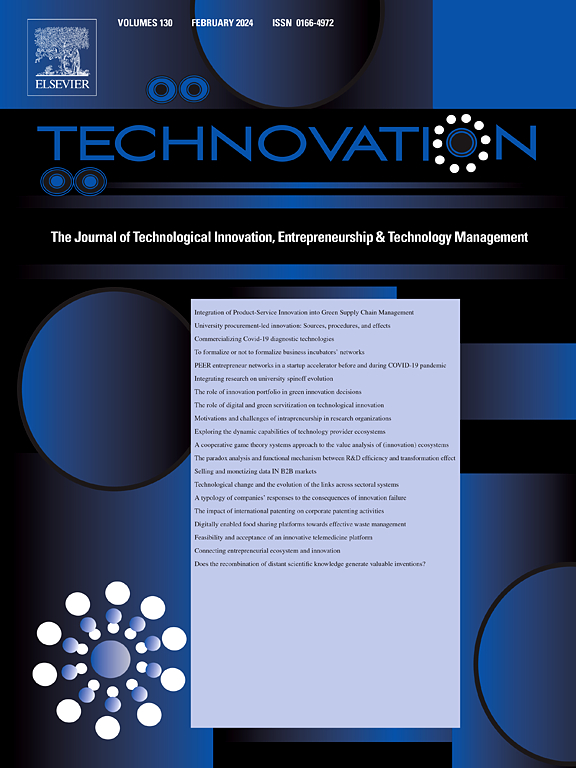专利混合所有制如何影响大学技术商业化?来自中国的证据
IF 10.9
1区 管理学
Q1 ENGINEERING, INDUSTRIAL
引用次数: 0
摘要
大学专利所有权已经引起了极大的关注,特别是在美国颁布了《拜杜法案》(Bayh-Dole Act)和欧洲废除教授特权之后。尽管知识生产取得了进步,但不同的所有权结构对大学创新的影响——特别是技术商业化(TC)——仍然是一个需要进一步研究的持续争论的话题。在中国,混合所有制政策的引入改变了传统的制度所有权结构,将部分专利所有权分配给了大学发明者。在此背景下,本文探讨了一个基本问题:新兴的大学管理政策是如何影响技术创新的,这种所有权结构是否更有效地促进了大学技术创新?本研究以2017年至2022年参加中央政府MO试点项目的大学为研究对象,采用差异中的差异(DID)方法评估其影响。研究结果表明:(1)MO政策催化了向发明人主导的商业化路径的转变,使研究人员能够直接参与市场机会,而机构主导的路径在很大程度上不受影响。(ii)内部商业化支持对提高政策效力至关重要。(iii) MO维护学术研究的完整性,消除商业化努力可能损害学术活动的担忧。此外,分析还揭示了政策在不同大学特征下的差异效应。这些研究结果有助于揭示专利所有权与大学创新之间的理论关系,有助于从总体角度理解大学创新及其对技术创新、知识产权管理和创新生态系统的影响。本文章由计算机程序翻译,如有差异,请以英文原文为准。
How does patent mixed ownership impact university technology commercialization? Evidence from China
University patent ownership has garnered significant attention, particularly following the enactment of the Bayh-Dole Act in the U.S. and the abolition of professor's privilege in Europe. Despite advancements in knowledge production, the impact of different ownership structures on university innovation—particularly technology commercialization (TC)—remains a topic of ongoing debate requiring further inquiry. In China, the introduction of a mixed ownership (MO) policy has altered the traditional institutional ownership structure by allocating partial patent ownership to university inventors. Within this context, this paper examines the fundamental question: How does the emerging MO policy influence TC and is this ownership structure more effective in promoting university TC? Focusing on universities that participated in the central government's MO pilot program between 2017 and 2022, this study employs a difference-in-differences (DID) approach to assess its impact. The findings reveal that: (i) the MO policy catalyzes a shift toward an inventor-led commercialization path, empowering researchers to directly engage with market opportunities, while leaving the institution-led path largely unaffected. (ii) internal commercialization support is essential in enhancing the policy's effectiveness. (iii) MO preserves the integrity of academic research, countering concerns that commercialization efforts may compromise scholarly activities. Furthermore, the analysis reveals differentiated effects of the policy across various university characteristics. These findings could shed light on the theoretical relationship between patent ownership and university innovation, contributing to the understanding of MO and its impact on TC, IP management and innovation ecosystem in a general perspective.
求助全文
通过发布文献求助,成功后即可免费获取论文全文。
去求助
来源期刊

Technovation
管理科学-工程:工业
CiteScore
15.10
自引率
11.20%
发文量
208
审稿时长
91 days
期刊介绍:
The interdisciplinary journal Technovation covers various aspects of technological innovation, exploring processes, products, and social impacts. It examines innovation in both process and product realms, including social innovations like regulatory frameworks and non-economic benefits. Topics range from emerging trends and capital for development to managing technology-intensive ventures and innovation in organizations of different sizes. It also discusses organizational structures, investment strategies for science and technology enterprises, and the roles of technological innovators. Additionally, it addresses technology transfer between developing countries and innovation across enterprise, political, and economic systems.
 求助内容:
求助内容: 应助结果提醒方式:
应助结果提醒方式:


